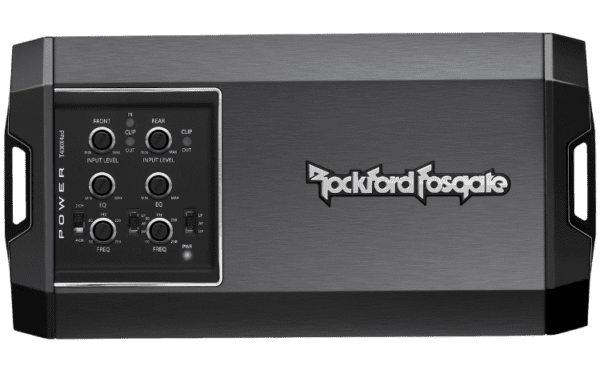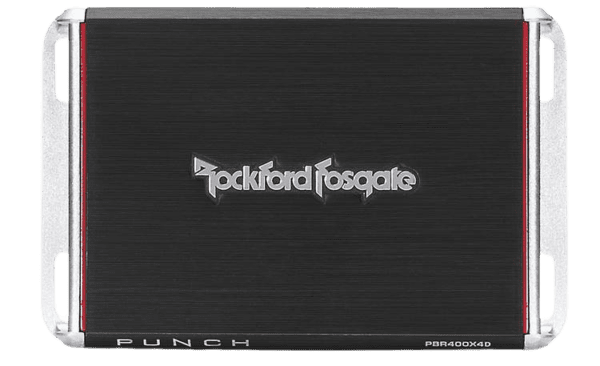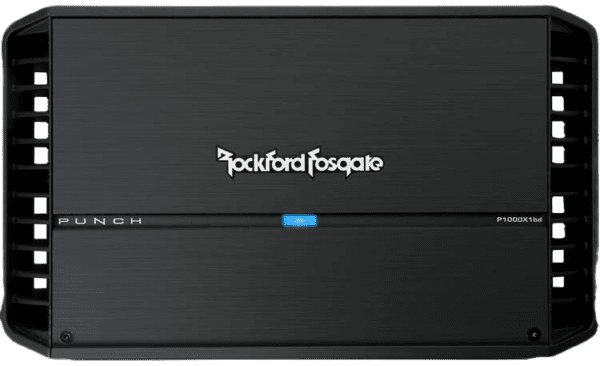Rockford Fosgate R2-750X5
$540.00
Prime Series 5-channel car amplifier — 50 watts RMS x 4 at 4 ohms + 350 watts RMS x 1 at 2 ohms
Give your system the power it deserves. Rockford Fosgate’s Prime Series R2-750X5 5-channel amplifier delivers a complete audio solution in one compact unit. It can power your front and rear speakers with 50 watts RMS each, while simultaneously driving a subwoofer with up to 350 watts RMS of clean, powerful bass.
This versatile Class-D amplifier offers multiple configuration options to match your specific audio needs. Use it in 5-channel mode for a full system, or bridge the amp to 3-channel mode to drive high-performance component speakers with 200 watts RMS each while still powering your subwoofer. The comprehensive filtering and adjustment options help you get maximum performance from all your speakers.
Product Highlights
- Type: 5-channel car amplifier (Prime Series)
- Power Output:
- 50 watts RMS × 4 + 200 watts RMS × 1 at 4 ohms
- 100 watts RMS × 4 + 350 watts RMS × 1 at 2 ohms
- 200 watts RMS × 2 bridged at 4 ohms + 350 watts RMS × 1 at 2 ohms
- CTA-2006 compliant: Standardized testing methodology
Key Features
- Class-D Efficiency: Powerful yet energy-efficient design
- Customizable Audio Control:
- Front & Rear Channels: Variable high-pass and low-pass filters (50-250 Hz, 12 dB/octave)
- Subwoofer Channel:
- Variable low-pass filter (50-250 Hz, 12 dB/octave)
- Variable Punch bass boost (0-12 dB at 45 Hz)
- Variable subsonic filter (15-40 Hz, 12 dB/octave)
- Easy Setup: C.L.E.A.N. gain system with clip lights ensures optimal sound quality
- Convenience Features:
- Included wired remote Punch Level Control for subwoofer
- Auto remote turn-on capability
- Compatible with both aftermarket and factory stereos via preamp and speaker-level inputs
Package Contents
- 5-Channel amplifier
- Wired Remote Level Control module with 16′ cable
- Speaker input harnesses and connection hardware
- Installation documentation and certification
Performance Specifications
- RMS Power Output:
- Full Range Channels: 50 watts × 4 at 4 ohms
- Subwoofer Channel: 200 watts × 1 at 4 ohms
- Power at 2 Ohms:
- Full Range Channels: 100 watts × 4
- Subwoofer Channel: 350 watts × 1
- Bridged Power: 200 watts × 2 at 4 ohms (full range channels)
- Minimum Impedance:
- Bridged: 4 ohms
- Unbridged: 2 ohms
- Frequency Response: 20-20,000 Hz
- THD at Rated RMS Power: 1%
- Signal-to-Noise Ratio:
- Full Range Channels: 80 dB
- Subwoofer Channel: 75 dB
- Input Voltage: 14.4V
- Fuse Rating: 120 amp (external)
- Replaces Previous Model: Rockford Fosgate R600X5
Physical Specifications
- Dimensions:
- Width: 11-1/4 inches
- Height: 2 inches (1-15/16 inches in spec sheet)
- Depth: 7-3/4 inches (6-13/16 inches in spec sheet)
- Mounting Options:
- Vertical, horizontal, or inverted
- Horizontal mounting recommended for best cooling
Amplifier Features
- Amplifier Class: D
- Built-in DSP: No
- Fan Cooled: No
- Remote Control: Yes (included for subwoofer channel)
Audio Controls
- Input Switch: 2-channel, 4-channel, or 5-channel selection
- In 2-channel mode, front input signal feeds all channels
- Independent Front/Rear Controls:
- Gain: Rotary controls (labeled 0-11)
- Input sensitivity: 150mV-4V line level or 450mV-12V speaker level
- Crossover: 3-position switch (low-pass, all-pass, high-pass)
- Low-pass range: 50-250 Hz (12 dB/octave Butterworth)
- High-pass range: 50-250 Hz (12 dB/octave Butterworth)
- Frequency: Rotary dials (50-250 Hz, continuously variable)
- Gain: Rotary controls (labeled 0-11)
- Subwoofer Channel Controls:
- Gain: Rotary control (labeled 0-11)
- Low-Pass Filter:
- Always engaged (cannot be bypassed)
- Frequency range: 50-250 Hz (12 dB/octave Butterworth)
- Infrasonic Filter:
- Variable: 15-40 Hz
- Slope: 12 dB/octave
- Bass Boost (Punch EQ):
- Range: 0 to +18 dB
- Frequency: 45 Hz
Remote Level Control
- Function: Controls subwoofer channel output level from dash or center console
- Dimensions:
- Width: 1.16″ (2″ including mounting flanges)
- Height: 0.92″
- Depth: 1.55″ (2.375″ including knob and wiring)
- Cable Length: 16 feet (RJ-25 connector on both ends)
Connectivity
- Power/Ground Terminals: Nickel-plated set-screw terminals (accommodate up to 4-gauge wire)
- Remote Turn-On Terminal: Nickel-plated set-screw terminal (accommodates up to 8-gauge wire)
- Speaker Terminals: Nickel-plated set-screw terminals (accommodate up to 8-gauge wire)
- Input Options:
- RCA inputs (three pairs: front, rear, and subwoofer)
- Speaker-level inputs with included harnesses
- Auto Turn-on Switch: For DC offset detection with speaker-level inputs
Installation Requirements
- External Fuse Required: 120-amp fuse placed within 18″ of battery
- No onboard fuses
- Recommended Wiring: 4-gauge power and ground wires
Package Contents (Detailed)
- 5-Channel amplifier
- Wired Remote Level Control module
- 16′ Remote cable (RJ-25 connector on both ends)
- Three 7″ Speaker input harnesses
- 3mm Allen Hex key
- Hardware:
- Four 3/4″ screws
- Two 1/2″ screws
- 5 flat washers
- 1 nut
- Documentation:
- Installation and Operation instructions (English/French/Spanish/German/Italian)
- Certificate of Performance
- Rockford Fosgate contact information
Configuration Options
- 5-Channel Mode: Power four speakers plus a subwoofer
- 4-Channel Mode: Power bridged front speakers, standard rear speakers, and a subwoofer
- 3-Channel Mode: Power two pairs of bridged speakers and a subwoofer





